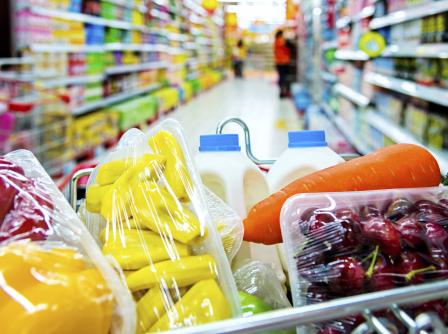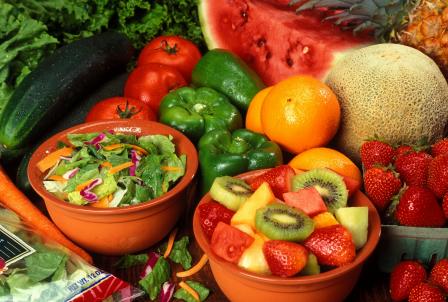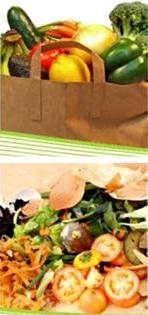Reducing Wasted Food At Home
Most people don't realize how much food they throw away every day — from uneaten leftovers to spoiled produce. EPA estimates that in 2018, about 68 percent of the wasted food we generated—or about 42.8 million tons-- ended up in landfills or combustion facilities. By managing food sustainably and reducing waste, we can help businesses and consumers save money, provide a bridge in our communities for those who do not have enough to eat, and conserve resources for future generations.
On this page:
- Benefits of Reducing Wasted Food
- Ways to Reduce Wasted Food
- Toolkit for Your Home and Your Community
Benefits of Reducing Wasted Food
- Saves money from buying less food.
- Reduces methane emissions from landfills and lowers your carbon footprint.
- Conserves energy and resources, preventing pollution involved in the growing, manufacturing, transporting, and selling food (not to mention hauling the food waste and then landfilling it).
- Supports your community by providing donated untouched food that would have otherwise gone to waste to those who might not have a steady food supply.
Ways to Reduce Wasted Food
Planning, prepping, and storing food can help your household waste less food. Below are some tips to help you do just that:
Planning Tips
 By simply making a list with weekly meals in mind, you can save money and time and eat healthier food. If you buy no more than what you expect to use, you will be more likely to keep it fresh and use it all.
By simply making a list with weekly meals in mind, you can save money and time and eat healthier food. If you buy no more than what you expect to use, you will be more likely to keep it fresh and use it all.
- Keep a running list of meals and their ingredients that your household already enjoys. That way, you can easily choose, shop for and prepare meals.
- Make your shopping list based on how many meals you’ll eat at home. Will you eat out this week? How often?
- Plan your meals for the week before you go shopping and buy only the things needed for those meals.
- Include quantities on your shopping list noting how many meals you’ll make with each item to avoid overbuying. For example: salad greens - enough for two lunches.
- Look in your refrigerator and cupboards first to avoid buying food you already have, make a list each week of what needs to be used up and plan upcoming meals around it.
- Buy only what you need and will use. Buying in bulk only saves money if you are able to use the food before it spoils.
Storage Tips
It is easy to overbuy or forget about fresh fruits and vegetables. Store fruits and vegetables for maximum freshness; they’ll taste better and last longer, helping you to eat more of them.
- Find out how to store fruits and vegetables so they stay fresh longer inside or outside your refrigerator.
- Freeze, preserve, or can surplus fruits and vegetables - especially abundant seasonal produce.
- Many fruits give off natural gases as they ripen, making other nearby produce spoil faster. Store bananas, apples, and tomatoes by themselves, and store fruits and vegetables in different bins.
- Wait to wash berries until you want to eat them to prevent mold.
- If you like to eat fruit at room temperature, but it should be stored in the refrigerator for maximum freshness, take what you’ll eat for the day out of the refrigerator in the morning.
Prep Tips
 Prepare perishable foods soon after shopping. It will be easier to whip up meals or snacks later in the week, saving time, effort, and money.
Prepare perishable foods soon after shopping. It will be easier to whip up meals or snacks later in the week, saving time, effort, and money.
- When you get home from the store, take the time to wash, dry, chop, dice, slice, and place your fresh food items in clear storage containers for snacks and easy cooking.
- Befriend your freezer and visit it often. For example,
- Freeze food such as bread, sliced fruit, or meat that you know you won’t be able to eat in time.
- Cut your time in the kitchen by preparing and freezing meals ahead of time.
- Prepare and cook perishable items, then freeze them for use throughout the month.
- For example, bake and freeze chicken breasts or fry and freeze taco meat.
Thriftiness Tips
Be mindful of old ingredients and leftovers you need to use up. You’ll waste less and may even find a new favorite dish.
- Shop in your refrigerator first! Cook or eat what you already have at home before buying more.
- Have produce that’s past its prime? It may still be fine for cooking. Think soups, casseroles, stir fries, sauces, baked goods, pancakes or smoothies.
- If safe and healthy, use the edible parts of food that you normally do not eat. For example, stale bread can be used to make croutons, beet tops can be sautéed for a delicious side dish, and vegetable scraps can be made into stock.
- Learn the difference between “sell-by,” “use-by,” “best-by,” and expiration dates.
- Are you likely to have leftovers from any of your meals? Plan an “eat the leftovers” night each week.
- Casseroles, stir-fries, frittatas, soups, and smoothies are great ways to use leftovers too. Search for websites that provide suggestions for using leftover ingredients.
- At restaurants, order only what you can finish by asking about portion sizes and be aware of side dishes included with entrees. Take home the leftovers and keep them for or to make your next meal.
- At all-you-can-eat buffets, take only what you can eat.
Toolkit for Your Home and Your Community
The Food: Too Good to Waste Toolkit will help you figure out how much food is really going to waste in your home and what you can do to waste less. By making small shifts in how you shop for, prepare, and store food, you can save time and money, and keep the valuable resources used to produce and distribute food from going to waste!
Food: Too Good to Waste also contains an Implementation Guide that is designed to teach local governments and community organizations how to implement a Food: Too Good to Waste campaign in their community using the Toolkit.
If You Can't Reduce Wasted Food, Divert It From Landfills
- Nutritious, safe, and untouched food can be donated to food banks to help those in need.
- Compost food scraps rather than throwing them away.

